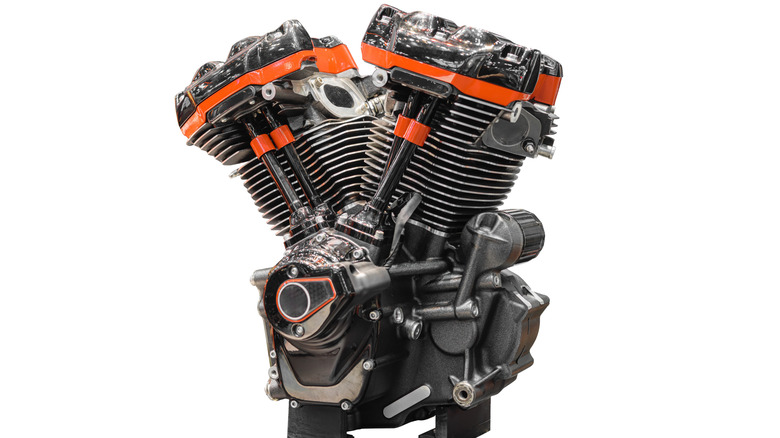Who Built The First V-Twin Motorcycle Engine? (It Wasn't Indian)
When most people think of V-Twin, they immediately think of motorcycles, but contrary to popular belief, the V-Twin engine's origin story had nothing to do with motorcycles. In fact, it was just a German experiment in compact power. In Bad Cannstatt, Germany, Gottlieb Daimler and Wilhelm Maybach built what we now recognize as the first actual V-Twin engine in 1889, calling it the "Standuhr" or "Grandfather Clock" because of its upright orientation. In the beginning, it had only two cylinders, configured at a 17-degree angle to run smoother and achieve higher power density than single-cylinder engines of the era, allowing it to produce more power for its size or weight.
When the engine was completed, putting it in motorcycles wasn't even a thought; the air-cooled engine was updated to a 20-degree angle and initially powered stationary machinery, boats, and Daimler's Stahlradwagen automobile. Despite that, Daimler and Maybach's engineering design and geometry became the blueprint for all V-Twins that followed, as splitting displacement between two cylinders while keeping the design compact was the winning formula for compact power and efficiency. The concept may have started in the automotive industry, but it laid the foundation for motorcycling's next giant step in Britain.
Princeps, the first true motorcycle V-Twin
The world's first production V-Twin motorcycle was built by Princeps AutoCar Company in Northampton, England, in November 1902, and was advertised in Motor Cycling magazine that same month. It featured a 4-horsepower, "Double Cylinder" engine mounted longitudinally (parallel to the frame), rather than transversely, which means the Cylinders are mounted against the frame, causing them to stick out. Moto Guzzi is an excellent example of this, and the main reason why people like their bikes. The longitudinal configuration is what caught on and became synonymous with powerful American cruisers.
The demand for higher-power, compact motorcycle engines fueled the V-Twin's spread across Europe, as manufacturers sought engines that could handle heavier bikes and deliver greater overall performance. The frames became heavier to withstand the increasing power from engines at the time. A CycleWorld article highlights this by detailing how Neckarsulmer Strickmaschinen Union (NSU) produced V-Twin motorcycles using Swiss-made engines that steadily increased from 3 to 5½ horsepower in the early 1900s. In 1903, Glenn H. Curtiss' high-performance V-Twin Hercules racer made its debut, an 8-horsepower motorcycle that set an American land speed record, clocking 64 mph. The Indian Motorcycle Company then released its first production V-Twin in 1907, followed by Harley-Davidson Motor Company in 1909, solidifying the V-Twin as an important piece of American motorcycling.
Modern V-Twins and the road ahead
Today's V-Twins have evolved a lot since their earlier mechanical simplicity, with refinements that have maximised power, efficiency, and reliability. Advancements, like overhead valves, boost power and smooth out engine performance, while other improvements, such as electronic fuel injection, which replaced carburetors, improve reliability and fuel control, all giving the engine new life while preserving its trademark torque delivery and sound. Harley-Davidson and Indian continue to refine the V-Twin engines in their cruisers. At the same time, European manufacturers take different approaches: Ducati focuses on higher compression ratios and desmodromic valves, and Moto Guzzi's transversely mounted engines are generally more focused on reliability, character, efficiency, and mid-range grunt.
You can now find modern V-Twins in just about everything from adventure bikes to high-output superbikes, blending compact size with broad torque curves. Due to its adaptability, the future looks bright as hybrid concepts are already on the way with Kawasaki's hybrid motorcycle. Engineers are actively studying V-Twin's geometry to learn more about mechanical balance and packaging efficiency, even as electric motorcycles become more widely available, proving that, after more than a century, Daimler's "Grandfather Clock," the V-Twin, remains one of the most enduring engine designs in transportation history.


